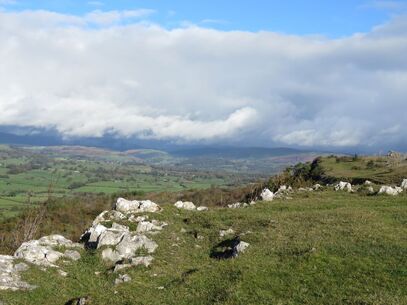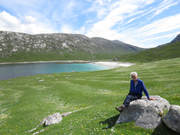 Scout Scar escarpment. Looking north-west to the fells
Scout Scar escarpment. Looking north-west to the fells Sunday morning is spectacular, with luminous white cloud enveloping the fells. Beneath a canopy of blue the Scout Scar ridge is well-lit. Slowly, the cloud-mass rises, the fells show faintly and a dark cloud over Morecambe Bay casts shadows across the Lyth Valley. It's a day of sensation. Climbing toward the ridge the warmth is lost to a chilly air. A flock flies silently overhead. I'm sure they're fieldfare but I wait to hear them and for the sun to show their colour before I claim my first sighting.
'How can any birds survive with all these dogs running off the lead?' asks a friend. Well, thank goodness for non-access land where birds sense they'll find safety. Toward Scout Scar, there's a secret place - the source of a ghyll where hawthorn grow thickly in a depression half-hidden from view and inaccessible. On this bright day I think I can hear fieldfare amongst mistle thrush and starling but the only bird that shows is a magpie. Next day I meet Peter, whose reports I trust, and he tells me he saw a flock of some two hundred fieldfare fly from high in a tree in just the spot where I heard them. Monday is cloudy and the light isn't so good but I hear mistle thrush and fieldfare and I photograph birds in hawthorn and about a holly with a rich crop of berries.
Flights of fieldfare call overhead but by now the light is poor. Being shrouded in mystery suits these birds that bring with them the magic of North. Nature isn't always revealed in a blaze of light and last winter the call of fieldfare invisible in mist over Scout Scar was so evocative.
















 RSS Feed
RSS Feed